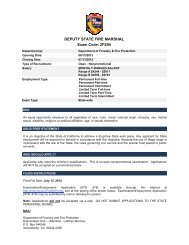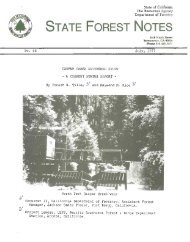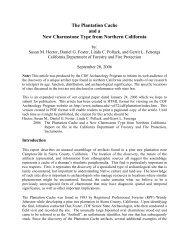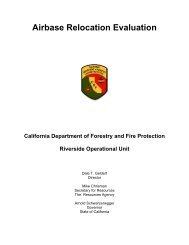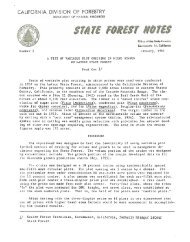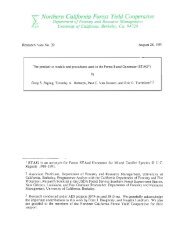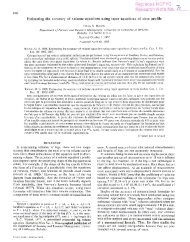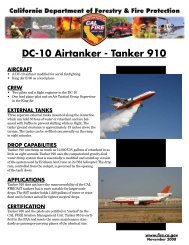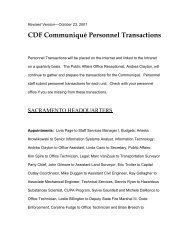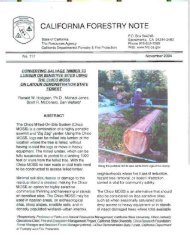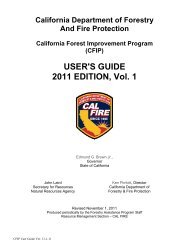State Forests Research and Demonstration Newsletter
State Forests Research and Demonstration Newsletter
State Forests Research and Demonstration Newsletter
You also want an ePaper? Increase the reach of your titles
YUMPU automatically turns print PDFs into web optimized ePapers that Google loves.
<strong>State</strong> <strong>Forests</strong> <strong>Research</strong> <strong>and</strong> <strong>Demonstration</strong><br />
Issue No. 1<br />
June 2003<br />
The Caspar Creek Watershed Study Completes<br />
40 Years of <strong>Research</strong><br />
<strong>State</strong> <strong>and</strong> Federal Cooperative <strong>Research</strong> at<br />
Caspar Creek Experimental Watersheds<br />
by Dr. Thomas Lisle, USFS<br />
For more than forty years, the California<br />
Department of Forestry <strong>and</strong> Fire Protection<br />
(CDF) <strong>and</strong> the USDA Forest Service, Pacific<br />
Southwest <strong>Research</strong> Station (PSW) have<br />
cooperated in a comprehensive watershed study<br />
at the Caspar Creek Experimental Watersheds<br />
on Jackson <strong>Demonstration</strong> <strong>State</strong> Forest near<br />
Fort Bragg. When formal cooperation began in<br />
1962, the objective was to document hydrologic<br />
changes, erosion impacts, <strong>and</strong> sediment<br />
production resulting from road construction <strong>and</strong><br />
logging second-growth forests. For the past 20<br />
years, the two agencies have jointly evaluated<br />
potential cumulative watershed effects resulting<br />
from even-age <strong>and</strong> uneven-age silviculture,<br />
including responses in streamflow routing,<br />
sediment transport, water quality, fisheries, <strong>and</strong><br />
other biological (algal <strong>and</strong> benthic macro<br />
invertebrate) communities. The Caspar Creek<br />
data represent the only long-term hydrologic<br />
information from managed second-growth conifer<br />
forests in the western U.S. Because of its long<br />
record <strong>and</strong> unique conditions, information from<br />
Caspar Creek will continue to be valuable to both<br />
California Dept. of Forestry & Fire Protection<br />
<strong>State</strong> <strong>Forests</strong> <strong>Research</strong> & <strong>Demonstration</strong> Program<br />
P.O. Box 944246<br />
Sacramento, CA 94244-2460<br />
Keep California Green <strong>and</strong> Golden<br />
Caspar Creek<br />
the research <strong>and</strong> the l<strong>and</strong> management<br />
communities as second- <strong>and</strong> third-growth<br />
forests are increasingly re-entered.<br />
This long-term cooperation between CDF <strong>and</strong><br />
PSW has been a productive division of labors.<br />
The two agencies have jointly decided which<br />
studies to undertake, with CDF supervising the<br />
construction <strong>and</strong> maintenance of research<br />
facilities <strong>and</strong> managing the experimental<br />
(continued on page 3)<br />
PRSRT STD<br />
U.S. Postage<br />
Paid<br />
Sacramento CA<br />
Permit # 924
Page 2 <strong>State</strong> <strong>Forests</strong> <strong>Research</strong> <strong>and</strong> <strong>Demonstration</strong> <strong>Newsletter</strong><br />
Road 600 Stream Crossing Removal<br />
As part of phase three of the Caspar Creek studies,<br />
some logging roads located in riparian zones are being<br />
decommisioned. The road system will be moved closer<br />
to the ridgetops of the watershed in an effort to reduce<br />
the number of stream crossings <strong>and</strong> sediment sources.<br />
This will also decrease culvert maintenence <strong>and</strong> longterm<br />
erosion of the stream bank at stream crossing<br />
locations. Proper road, l<strong>and</strong>ing, <strong>and</strong> crossing design is<br />
the key to minimizing environmental damage <strong>and</strong> the<br />
costs of construction <strong>and</strong> maintenance. New <strong>and</strong><br />
reconstructed roads <strong>and</strong> l<strong>and</strong>ings will be outsloped for<br />
surface drainage.<br />
Caspar Creek Watershed<br />
Caspar Creek lies approximately five miles<br />
south of Fort Bragg, California <strong>and</strong> sits right<br />
about in the middle of Jackson <strong>Demonstration</strong><br />
<strong>State</strong> Forest. It covers 2,400 acres of<br />
second-growth conifer forestl<strong>and</strong> containing<br />
coast redwood, Douglas-fir, western<br />
hemlock <strong>and</strong> gr<strong>and</strong> fir. The hills are uplifted<br />
marine terraces deeply incised by<br />
antecedent drainages <strong>and</strong> the soils of the<br />
basins are well-drained clay-loams. The<br />
climate is typical of low-elevation watersheds<br />
on the central North American<br />
Pacific coast where winters are mild <strong>and</strong><br />
wet while summers are cool <strong>and</strong> dry. The<br />
Caspar Creek Watershed Study is one of<br />
the most intensive long-term paired<br />
watershed studies in the world, <strong>and</strong> over<br />
150 technical publications have been<br />
authored using the data collected here.<br />
North Fork Weir<br />
The North <strong>and</strong> South Fork Weirs<br />
were installed in 1962 for phase one<br />
of the Caspar Creek Watershed<br />
Study. Measurments taken at these<br />
weirs have also been used in phase<br />
two <strong>and</strong> phase three. Each weir<br />
includes a fish ladder for spawning<br />
salmon <strong>and</strong> calibrated gages for<br />
measuring the suspended sediment<br />
load, or turbidity, carried by the water<br />
before, during <strong>and</strong> after road<br />
construction <strong>and</strong> timber operations.<br />
The weirs also measure streamflow,<br />
which changes with the seasons <strong>and</strong><br />
can increase dramatically during<br />
storm events.
Page 3 <strong>State</strong> <strong>Forests</strong> <strong>Research</strong> <strong>and</strong> <strong>Demonstration</strong> <strong>Newsletter</strong><br />
“The results to<br />
date <strong>and</strong> a<br />
continuation of<br />
this cooperation<br />
will be priceless<br />
to future generations.”<br />
continued from page 1<br />
watersheds, <strong>and</strong> PSW designing the<br />
experiments <strong>and</strong> analyzing the data. Together,<br />
CDF <strong>and</strong> PSW have authored over 150 technical<br />
publications as a result of this joint effort. These<br />
are listed on the web page of the Redwood<br />
Sciences Laboratory <strong>and</strong> many are available online<br />
at www.rsl.psw .fs.fed.us.<br />
Small experimental watersheds such as<br />
those at Caspar Creek permit detailed studies of<br />
physical <strong>and</strong> biological interactions in a<br />
relatively controlled environment. Experimental<br />
disturbances can be imposed at a temporal <strong>and</strong><br />
spatial scale that allows the researcher a<br />
chance of correctly identifying cause <strong>and</strong> effect.<br />
Further, although such small-watershed studies<br />
are only case studies, they can establish some<br />
sideboards on the more outrageous claims that<br />
appear now <strong>and</strong> then. It is not unusual to hear<br />
claims that “logging will dry up the streams <strong>and</strong><br />
springs” or “logging will produce devastating<br />
floods” or “logging does not increase stream<br />
sediment loads.” The Caspar Creek studies<br />
have shown that none of these claims are true<br />
for the conditions found at Caspar Creek. For<br />
example, logging about half the timber volume,<br />
either by clearcut or selective cut, did not have a<br />
significant effect on important peak streamflows,<br />
that is, those flows affecting the morphology of<br />
the channel. However, increased stormflow<br />
volume after logging was most important in<br />
explaining increased suspended sediment load.<br />
Further, logging increased soil moisture <strong>and</strong><br />
summer low flow, subsurface <strong>and</strong> soil pipe flow,<br />
woody debris, <strong>and</strong> modified other riparian<br />
conditions.<br />
Results from Caspar Creek are being used<br />
by state <strong>and</strong> federal agencies charged with<br />
regulating how forestry practices affect flooding,<br />
water supply, water quality, riparian condition,<br />
aquatic habitat including endangered fish.<br />
Because of a renewed emphasis on sciencebased<br />
decision-making, the results are invoked<br />
frequently by advocates from all sides in<br />
debates over forest management in northern<br />
California. In addition, sampling methods<br />
developed recently at Caspar Creek for<br />
measuring sediment loads are being adopted for<br />
monitoring by agencies, non-profits, <strong>and</strong> private<br />
industry as forest impacts come under<br />
increasing public scrutiny.<br />
The present condition of the South Fork<br />
watershed is typical of much of the tractoryarded<br />
l<strong>and</strong>s in the redwood region that are<br />
entering their third harvest cycle. It is<br />
becoming evermore important for l<strong>and</strong>owners,<br />
regulatory agencies, <strong>and</strong> the public to<br />
underst<strong>and</strong> the interactions between proposed<br />
future activities <strong>and</strong> prior disturbances.<br />
Therefore, a third phase of studies is being<br />
initiated in the South Fork, where 10 new<br />
gaging stations were installed in 2000 to<br />
examine the effects of selection or group<br />
selection harvesting on runoff <strong>and</strong> sediment<br />
production from previously tractor-logged<br />
redwood forests.<br />
Such a long-term research <strong>and</strong><br />
management venture between a state <strong>and</strong><br />
federal agency is unique. The results to date<br />
<strong>and</strong> a continuation of this cooperation will be<br />
priceless to future generations. Consequently,<br />
CDF <strong>and</strong> PSW have agreed in principle to<br />
continue cooperative research at the Caspar<br />
Creek Experimental Watersheds for the next<br />
100 years. This may seem like a long<br />
commitment, but this is the time frame upon<br />
which forest l<strong>and</strong> managers must operate. To<br />
better foster this long-term cooperative work, a<br />
barracks/office facility is now being constructed<br />
as the first phase of what will become the<br />
Jackson <strong>Demonstration</strong> <strong>State</strong> Forest Learning<br />
Center.<br />
Thomas E. Lisle is a <strong>Research</strong> Hydrologist<br />
with the USDA Forest Service, Pacific Southwest<br />
<strong>Research</strong> Station
Page 4 <strong>State</strong> <strong>Forests</strong> <strong>Research</strong> <strong>and</strong> <strong>Demonstration</strong> <strong>Newsletter</strong><br />
Current <strong>Research</strong> Projects at Caspar Creek<br />
Hydrologic-Response Simulations for<br />
Caspar Creek: A Process-Based Characterization<br />
of Cumulative Watershed Effects<br />
<strong>Research</strong>er: Adrianne Carr, PhD Project<br />
Stanford University<br />
It is well known, in a qualitative sense, that forest<br />
management practices can give rise to<br />
cumulative watershed effects (CWEs). The<br />
science associated with assessing CWEs has<br />
been primarily empirically-based. There is a huge<br />
gap in the underst<strong>and</strong>ing of the physical<br />
processes that control the changes in watershed<br />
function resulting from timber harvest <strong>and</strong> the<br />
associated activities. The approach used in my<br />
research is physics-based numerical simulation<br />
of surface <strong>and</strong> near-surface hydrologic response<br />
for forested systems designed to test the<br />
hypothesis that timber harvest can alter<br />
watershed function. The study includes<br />
comprehensive numerical simulation combined<br />
with <strong>and</strong> driven by rigorous field study to address<br />
questions related to hydrologic response at the<br />
sub-watershed <strong>and</strong> watershed scales. At the<br />
heart of this work are (i) the well-characterized<br />
experimental watershed (Caspar Creek) <strong>and</strong> (ii) a<br />
state-of-the-art, physically-based hydrologicresponse<br />
model (the Integrated Hydrology Model).<br />
Changes in hydrologic response resulting from<br />
alternative l<strong>and</strong> management activities will be<br />
investigated in a “what if” simulation mode. The<br />
numerical experiments in this study will aid in the<br />
concept development of both future field <strong>and</strong><br />
modeling studies of hydrologic response <strong>and</strong><br />
facilitate the quantitative characterization of dataworth<br />
relationships as they are related, for<br />
example, to future monitoring strategies designed<br />
to underst<strong>and</strong> CWEs at the watershed scale.<br />
Road Sedimentation Model<br />
<strong>Research</strong>er: Chris Keithley<br />
CDF Fire <strong>and</strong> Resources Assessment Program<br />
Previous studies within forested watersheds<br />
in northern California have shown that the<br />
location <strong>and</strong> condition of the road within a<br />
watershed can have a significant effect on the<br />
amount of erosion associated with the road<br />
system. As a result many forests are developing<br />
road management plans to efficiently reduce<br />
road related sediment. A road sedimentation<br />
model, SEDMODL, was applied to the Caspar<br />
Creek watershed on the Jackson <strong>Demonstration</strong><br />
<strong>State</strong> Forest. The model was developed by Boise<br />
Cascade for forest l<strong>and</strong>s in Idaho <strong>and</strong><br />
Washington. The structure of the model is<br />
flexible enough to easily adapt it to forest l<strong>and</strong>s<br />
in northern California.<br />
The model was run on Caspar Creek to<br />
evaluate the contribution of roads as part of the<br />
basin’s sediment budget <strong>and</strong> to assist in<br />
identifying roads that produce relatively high<br />
amounts of sediment. Model results suggest that<br />
while the ratio of road sediment to background<br />
sediment is fairly high (2x), less than half of the<br />
roads are expected to contribute significant<br />
sediment to streams <strong>and</strong> an even smaller portion<br />
of road segments would be considered chronic<br />
sources. The first run used the entire road<br />
network to estimate sediment yield. The second<br />
model run took into account the removal of over<br />
4.5 miles of roads that have been slated for<br />
decommission. Removal of 7% of the total road<br />
network reduced predicted road sediment by 9%.<br />
The model has yet to be validated with field<br />
observations. A comparison of current sediment<br />
yield estimates from SEDMODL with estimates<br />
from independent studies indicates that the<br />
model results are close to field based estimates.<br />
When used as a screening tool the model will<br />
provide first level estimates of road<br />
sedimentation, assist in identifying roads that are<br />
currently chronic sources of sediment, <strong>and</strong> guide<br />
a cost effective plan to reduce road based<br />
sediment.
Page 5 <strong>State</strong> <strong>Forests</strong> <strong>Research</strong> <strong>and</strong> <strong>Demonstration</strong> <strong>Newsletter</strong><br />
Turbidity Threshold Sampling<br />
<strong>Research</strong>er: USFS, Redwood Sciences Laboratory,<br />
Pacific Southwest <strong>Research</strong> Station<br />
Since 1962, researchers have been studying<br />
the nature of hydrologic erosion <strong>and</strong> sedimentation<br />
impacts of logging operations on northern California<br />
watersheds. Turbidity threshold sampling was<br />
first implemented in water year 1996 at eight<br />
gaging stations in the Caspar Creek watershed.<br />
One additional gaging station was added in 2000<br />
<strong>and</strong> ten more gaging stations were added in water<br />
year 2001. The data include: streamflow, turbidity,<br />
estimated sediment loads, with the additional<br />
collection of water <strong>and</strong> air temperature <strong>and</strong> rainfall<br />
at selected sites. Data are collected <strong>and</strong> maintained<br />
by Redwood Sciences Laboratory, in<br />
cooperation with CDF.<br />
Turbidity threshold sampling is an automated<br />
procedure for collecting data on suspended<br />
sediment in the water. The basic equipment<br />
Collecting stream flow data at Jackson <strong>Demonstration</strong> <strong>State</strong><br />
Forest. The data logger takes a sample every 30 minutes.<br />
consists of a programmable data logger, a turbidimeter<br />
mounted in the stream, a pumping sampler,<br />
<strong>and</strong> a stage-measuring device.<br />
Recent <strong>Research</strong> Projects at Caspar Creek<br />
Road Ab<strong>and</strong>onment Study - Bill Baxter, CDF<br />
Large Woody Debris Installation <strong>and</strong> Monitoring<br />
Bill Baxter, CDF<br />
Tree-falling Study - Bill Baxter, CDF<br />
South Fork Weir<br />
Interception Study - E.T. Keppler, USFS, Jack Lewis,<br />
USFS, R<strong>and</strong> Eads, USFS<br />
Fog Drip Study - E.T. Keppler, USFS, Jack Lewis, USFS,<br />
R<strong>and</strong> Eads, USFS<br />
Gully Study - Nick Dewy, Graduate Student, Humboldt <strong>State</strong><br />
University, Tom Lisle, USFS, Leslie Reid, USFS<br />
Road Subsurface Study - E.T. Keppler, USFS<br />
L<strong>and</strong>slide Inventory & Database - E.T. Keppler, USFS<br />
Evaluating Forst Management Effects on<br />
Erosion, Sediment, <strong>and</strong> Runoff, R.M. Rice & R.R.<br />
Ziemer, USFS<br />
Composition of Suspended Load as a Measure of<br />
Stream Health - Mary Ann Madej, Ph.D., USGS, Margaret<br />
Wilzbach, Ph.D. USGS<br />
Annual Dept. of Fish & Game Salmonid Inventory
Page 6 <strong>State</strong> <strong>Forests</strong> <strong>Research</strong> <strong>and</strong> <strong>Demonstration</strong> <strong>Newsletter</strong><br />
For more<br />
information on<br />
the Caspar<br />
Creek Watershed<br />
studies visit<br />
the USFS<br />
website at<br />
www.fs.fed.us/<br />
psw<br />
Caspar Creek Hydrologic <strong>and</strong> Geomorphic Data: A<br />
Consultant’s Perspective<br />
By Matthew O’Connor, PhD, RG<br />
During periods of tight government budgets, it<br />
may be tempting to suggest that expensive<br />
research projects are an unaffordable luxury<br />
lacking in tangible benefits. <strong>Research</strong> at the<br />
Caspar Creek Experimental Watershed is NOT<br />
vulnerable to this criticism. As an environmental<br />
consultant who deals with issues pertaining to<br />
the effects of l<strong>and</strong> uses such as timber harvest<br />
<strong>and</strong> timberl<strong>and</strong> conversion on hydrologic <strong>and</strong><br />
geomorphic processes, I have routinely<br />
referenced research studies <strong>and</strong> utilized data<br />
from Caspar Creek. Jackson Demonstation<br />
<strong>State</strong> Forest <strong>and</strong> the U.S. Forest Service<br />
Redwood Sciences Laboratory<br />
(www.rsl.psw.fs.fed.us) have made much of the<br />
data <strong>and</strong> virtually all of the research papers from<br />
Caspar Creek available via the Internet.<br />
Watershed studies at Caspar Creek have<br />
investigated erosion <strong>and</strong> sedimentation,<br />
streamflow, runoff processes, slope stability,<br />
large woody debris, water temperature <strong>and</strong> fish<br />
habitat issues, to name a few. These studies<br />
<strong>and</strong> hydrologic data sets provide researchers,<br />
consultants <strong>and</strong> regulatory agencies with the<br />
most comprehensive information available on<br />
second growth redwood forest ecosystems. The<br />
hydrologic data is unique in its level of intensity<br />
of monitoring <strong>and</strong> the ever-lengthening period of<br />
record. Techniques developed to measure<br />
stream flow <strong>and</strong> sediment yield at Caspar Creek<br />
have been refined over the past twenty years,<br />
<strong>and</strong> have been widely adopted by other<br />
researchers <strong>and</strong> public watershed groups.<br />
It is fair to characterize the existing research<br />
results as invaluable, however, the ongoing<br />
nature of watershed studies at Caspar Creek<br />
creates the prospect of ever more valuable<br />
continuous data sets. Maintenance of<br />
hydrologic monitoring <strong>and</strong> development of a new<br />
experiment in the South Fork Caspar Creek<br />
ensures that the full value of previous data will be<br />
realized, <strong>and</strong> that current questions relating to<br />
the effects of management on aquatic systems<br />
are addressed through new research.<br />
Adaptation of research questions <strong>and</strong> related<br />
experiments to the evolving field of watershed<br />
science parallels the oft-cited adaptive<br />
management approach to natural resources<br />
management.<br />
The Caspar Creek Experimental Watershed<br />
has provided scientific data of great value for<br />
evaluation <strong>and</strong> assessment of environmental<br />
impact of timber harvest <strong>and</strong> other management<br />
of coastal forests in the northern Califorina Coast<br />
Ranges. Long-term hydrologic data, <strong>and</strong> the<br />
opportunity for new experiments in watershed<br />
sciences to evaluate effects of management, will<br />
not be easily duplicated anywhere else in the<br />
redwood region.<br />
Matthew O’Connor is a registered geologist <strong>and</strong><br />
owner of O’Connor Environmental, Inc.,<br />
Healdsburg, California
Page 7 <strong>State</strong> <strong>Forests</strong> <strong>Research</strong> <strong>and</strong> <strong>Demonstration</strong> <strong>Newsletter</strong><br />
For more<br />
information on<br />
California’s <strong>State</strong><br />
<strong>Forests</strong> visit the<br />
CDF website at<br />
www.fire.ca.gov<br />
<strong>State</strong> Forest Contacts<br />
Jackson <strong>Demonstration</strong> <strong>State</strong> Forest<br />
802 N. Main Street (Hwy 1)<br />
Fort Bragg, CA 95437<br />
Forest Manager - Marc Jameson<br />
(707) 964-5674<br />
Boggs Mountain <strong>Demonstration</strong> <strong>State</strong> Forest<br />
P.O. Box 839<br />
Cobb, CA 95426<br />
Forest Manager - Norm Benson<br />
(707) 928-4378<br />
LaTour <strong>Demonstration</strong> <strong>State</strong> Forest<br />
875 Cypress Ave.<br />
Redding, CA 96001<br />
Forest Manager - Scott McDonald<br />
(530) 225-2505<br />
Jackson<br />
<strong>Demonstration</strong> <strong>State</strong><br />
Forest<br />
Las Posadas<br />
<strong>Demonstration</strong> <strong>State</strong><br />
Forest<br />
Soquel<br />
<strong>Demonstration</strong> <strong>State</strong><br />
Forest<br />
Ellen Pickett<br />
<strong>Demonstration</strong> <strong>State</strong><br />
Forest<br />
Tecate Peak<br />
<strong>State</strong> <strong>Research</strong> Area<br />
LaTour<br />
<strong>Demonstration</strong> <strong>State</strong><br />
Forest<br />
Boggs Mountain<br />
<strong>Demonstration</strong> <strong>State</strong><br />
Forest<br />
Mount Zion<br />
<strong>Demonstration</strong> <strong>State</strong><br />
Forest<br />
Mountain Home<br />
<strong>Demonstration</strong><br />
<strong>State</strong> Forest<br />
Soquel <strong>Demonstration</strong> <strong>State</strong> Forest<br />
4750 Soquel-San Jose Road<br />
Soquel, CA 95073<br />
Forest Manager - Thom Sutfin<br />
(831) 475-8643<br />
Mountain Home <strong>Demonstration</strong> <strong>State</strong> Forest<br />
P.O. Box 517<br />
Springville, CA 93265<br />
Forest Manager - Jose Medina<br />
(559) 539-2321 Summer<br />
(559) 539-2855 Winter<br />
CDF operates eight demonstration<br />
<strong>State</strong> <strong>Forests</strong> totaling 71,000 acres,<br />
<strong>and</strong> one <strong>State</strong> <strong>Research</strong> Area. Five of<br />
the forests are actively managed for<br />
research <strong>and</strong> demonstration of<br />
economical forest management <strong>and</strong><br />
timber production. Scientists, research<br />
consultants, <strong>and</strong> graduate students<br />
also use the forests as laboratories for<br />
a variety of topics including watershed<br />
studies, threatened <strong>and</strong> endangered<br />
species conservation <strong>and</strong> ecological<br />
research. The results of their<br />
research is published in scientific<br />
journals or CDF report publications.<br />
The Board of Forestry <strong>and</strong> Fire<br />
Protecion policy provides that the<br />
primary purpose of the <strong>State</strong> forest<br />
program is to conduct innovative<br />
demonstrations, experiments, <strong>and</strong><br />
education in forest management.<br />
Accordingly, the Department will<br />
conduct a balanced program of<br />
demonstrations <strong>and</strong> investigations in<br />
silviculture, mensuration, logging<br />
methods, economics, hydrology,<br />
environmental protection, <strong>and</strong><br />
recreation directed to the needs of the<br />
general public, small forest l<strong>and</strong>owners,<br />
timber operators <strong>and</strong> the timber<br />
industry.




